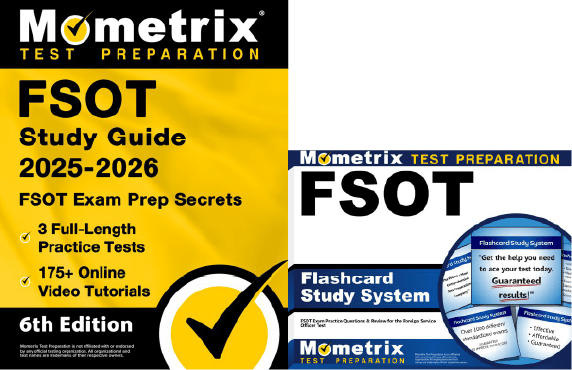If you need help studying for the FSOT exam or just want some more information about what the test is like, you’ve come to the right place.
Click below to take a free FSOT practice test!
What’s on the Exam?
How to Register
Exam Scores
Retaking the Exam
Online FSOT Prep Course
What Test-Takers Are Saying
Exam Eligibility
To be eligible to register to take the FSOT exam, you need to be a US citizen between 20 and 59 years old.
What’s on the Exam?
The test is split into three parts:
- Logic and Reasoning
- Job Knowledge
- English Expression
The time limit for the exam is about 3 hours. There aren’t any scheduled breaks, but you’re free to take restroom breaks as needed.
How to Register
To get started, you’ll need to create a Pearson VUE account and submit an application. The application will ask you for your contact information and any documentation to prove your eligibility (among other things).
When you submit the application, you’ll also need to submit the hold fee, which is $5. The hold fee is exactly what it sounds like—a fee to hold your spot for the test. The good news is that the $5 will be returned to you after you take the test!
Exam Scores
For the multiple-choice sections of the test, the scores for each section are combined into a total score.
The passing scores are based on the performance of all of the candidates taking the exam, so the scores you need will vary.
Retaking the Exam
If you didn’t get a passing score on your first try, that’s okay! You can retake the test after a one-year waiting period.
A year seems like a long time to have to wait, but you can use that time to study and improve your knowledge and skills before trying again!
Online FSOT Prep Course
If you want to be fully prepared, Mometrix offers an online FSOT prep course. The course is designed to provide you with any and every resource you might want while studying. The FSOT course includes:
The FSOT prep course is designed to help any learner get everything they need to prepare for their FSOT exam. Click below to check it out!
What Test-Takers Are Saying
Don’t just take our word for it! See what real test-takers are saying about the new October 2025 version of the FSOT:
“I first took it eight years ago, and the new version has changed a lot. Having no essay was nice. Logic was more fun than the “how many foreigners do you know” biographic questions on the old test.”

terekkincaid
“I wouldn’t focus on re-reading entire Logic and Reasoning sections. Instead, I would review strategies that actually improve performance, such as pacing drills, answer choice elimination, skipping and returning to difficult questions, pre-phrasing possible answers, and flagging time traps.”

HumanChallet
“Generally, the more you know about everything, the better your chances will be when answering the random assortment of JK questions. It’s a wild mix of arithmetic, stats, economics, policy, geography, psychology, management, technology, and history (both US and World) questions.”

Spartan10142
Mometrix Test Preparation is not affiliated with or endorsed by any official testing organization. All organizational and test names are trademarks of their respective owners.



 FSOT Online Course
FSOT Online Course FSOT Study Guide
FSOT Study Guide FSOT Flashcards
FSOT Flashcards

